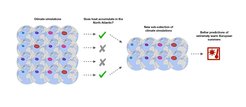Improving predictions of hot summers in Europe
Hot summers in Europe can be better predicted if an increase of the heat content in the North Atlantic is taken into account

To the point
- Heat indicator in the ocean: European heat waves are often preceded by an increase in the North Atlantic heat content
- Better predictions: Model simulations that take into account the connection with the heat content in the Northern Atlantic predict past European heat waves more reliably than calculations which omit this mechanism.
- Hot summer in 2025: Calculations, which were not part of the current study, show that extraodinary heatwaves can be expect for this year’s summer in Europe.
In Europe, people are increasingly exposed to extreme heat events – with serious consequences for human health, ecosystems, and agriculture. Researchers at the Max Planck Institute for Meteorology have developed and tested a method that can be used to improve the prediction of European hot summers up to a few years in advance.
Hot summers in Europe are preceded by a build-up of heat in the North Atlantic
A crucial clue to impending heat waves can be found in the ocean: In an earlier study, Lara Wallberg, researcher at the Max Planck Institute for Meteorology and colleagues showed that anomalously warm European summers are often preceded by a build-up of heat in the North Atlantic. This heat build-up occurs up to three years before an extremely warm summer. In their new study, Lara Wallberg, Laura Suarez-Gutierrez (ETH Zurich & LSCE Paris), and Max Planck-researchers Daniela Matei, Daniel Krieger, and Wolfgang Müller have shown that a corresponding physical indicator can be used to improve predictions of extremely warm European summers.
As a kind of by-product of the current study, the researchers can also make a prediction for the summer of 2025 in this way: “Model calculations that take into account the connection between heat extremes and the heat content in the North Atlantic also predict a hot summer in Europe in 2025,” says Lara Wallberg. This is in line with forecasts from the European Center for Medium-Range Weather Forecasts, which also predict that this summer will be very hot.
Using the climate model MPI-ESM-LR, which was developed at Max Planck Institute for Meteorology, scientists from the University of Hamburg calculated several simulations with slightly different initial conditions – a so-called ensemble. From such an ensemble, Wallberg and her colleagues filtered out those model runs that adequately represented the relevant North Atlantic mechanism, as indicated by anomalies of the North Atlantic current. Only a handful of the simulations reproduced the relationship between heat content and heatwave summers. They depicted past heat summers more reliably than the model runs in which the causal link did not appear. For further analysis, the researchers therefore selected the simulations that reproduced the relationship between North Atlantic heat accumulation and heat extremes.

More precise model calculations for past summers
To test the quality of the resulting prediction, they used a so-called hindcast experiment: a prediction for a period that already lies in the past. This allowed them to compare the results with reanalysis data in the period from 1964 to 2021, during which time 18 above-average warm summers occurred in Europe. The result: After applying the method, ten of these summers, the total number of hot summer days within these summers, as well as the amplitude and variability of the extremes are predicted more reliably.
On the one hand Wallberg is now investigating whether the approach could have been used to predict the regional characteristics of the extremely warm summers of 2003, 2018, and 2022 as early as three years in advance. In particular, she is also looking at growing degree days to see if the method can provide valuable information for agriculture, for example. On the other hand she cooperates with farmers among others in an EU funded project to make the forecasts available for practical use.

